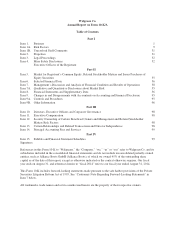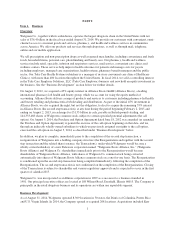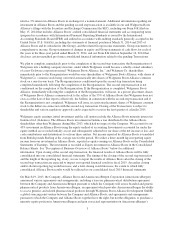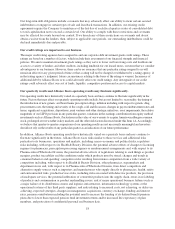Walgreens 2014 Annual Report Download - page 18
Download and view the complete annual report
Please find page 18 of the 2014 Walgreens annual report below. You can navigate through the pages in the report by either clicking on the pages listed below, or by using the keyword search tool below to find specific information within the annual report.to accept lower reimbursement rates in order to secure preferred relationships with Medicare Part D plans serving
senior patients with significant pharmacy needs. Because our Medicare Part D reimbursement rates will decrease
in calendar year 2015, if we are not able to generate additional prescription volume and other business from
patients participating in these programs sufficient to offset the impact of lower reimbursement, our gross profit
will be adversely affected.
Our profitability can be significantly adversely affected by a decrease in the introduction of new brand
name and generic prescription drugs.
Our sales and profit margins can be adversely affected by the introduction of new brand name and generic
drugs. New brand name drugs can result in increased drug utilization and associated sales revenues, while the
introduction of lower priced generic alternatives typically results in relatively lower sales revenues, but higher
gross profit margins. Accordingly, a decrease in the number of significant new brand name drugs or generics
successfully introduced could adversely affect our results of operations.
Generic drug inflation could have a significant adverse effect on our profitability.
Overall increases in the amounts we pay to procure generic drugs, commonly referred to as generic drug
inflation, could have a significant adverse effect on our profitability. In addition, our gross profit margins would
be adversely affected by continued generic inflation to the extent we are not able to offset such cost
increases. We experienced a shift from historical patterns of deflation in generic drug costs to inflation in fiscal
2014. During fiscal 2014, we experienced cost increases on a subset of generic drugs and in some cases these
increases have been significant. We expect this generic inflation to continue in fiscal 2015. Our existing
reimbursement arrangements with payers generally provide us with only limited protection against cost increases
in our generic drug procurement costs. We are seeking to address this through changes in our contracting
strategies and negotiations with our vendors and payers. We cannot assure you that we will be able to mitigate
the impact of increased inventory acquisition costs, in whole or in part. Failure to fully offset any such increased
prices and costs or to modify our activities to mitigate the impact could have a significant adverse effect on our
gross profit margins.
We derive a significant portion of our sales from prescription drug sales reimbursed by pharmacy benefit
management companies.
We derive a significant portion of our sales from prescription drug sales reimbursed through prescription drug
plans administered by pharmacy benefit management (PBM) companies. PBM companies typically administer
multiple prescription drug plans that expire at various times and provide for varying reimbursement rates. There
can be no assurance that we will continue to participate in any particular pharmacy benefit manager network in
any particular future time period. If our participation in the prescription drug programs administered by one or
more of the large PBM companies is restricted or terminated, we expect that our sales would be adversely
affected, at least in the short term. If we are unable to replace any such lost sales, either through an increase in
other sales or through a resumption of participation in those plans, our operating results may be materially
adversely affected. For example, we were not part of the pharmacy provider network of Express Scripts, Inc., one
of the largest PBMs, for more than eight months in 2012, which led most patients in plans administered by
Express Scripts that we formerly served to transition to a new pharmacy and caused us to lose significant sales
and adversely affected our operating results. When we exit a pharmacy provider network and later resume
network participation, there can be no assurance that we will achieve any particular level of business on any
particular pace. In addition, in such circumstances we may incur increased marketing and other costs in
connection with initiatives to regain former patients and attract new patients covered by in-network plans. When
we exit a pharmacy provider network and later resume network participation, there also can be no assurance that
all clients of the PBM sponsor of the network will choose to include us again in their pharmacy network initially
or at all. For example, after we agreed with Express Scripts to again become part of the broadest network of
pharmacies available to Express Scripts clients as of September 15, 2012, the United States Department of
Defense TRICARE program, an Express Scripts client, announced that Walgreens would continue to be
designated as a non-network pharmacy provider for TRICARE beneficiaries.
10
























